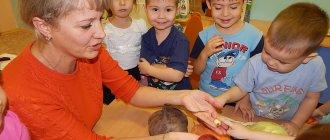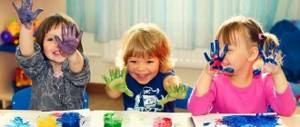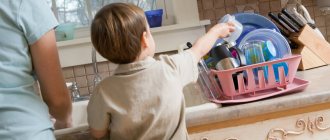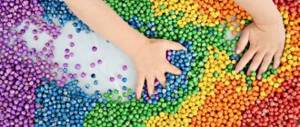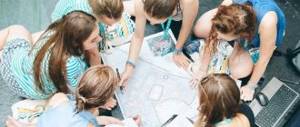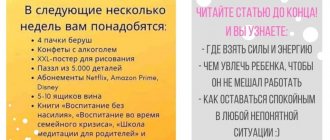Safety precautions
To ensure that the experiment is not overshadowed by anything, it is very important to follow the safety rules:
- All experiments should only be carried out under adult supervision;
- It is advisable to use exclusively materials that are safe for children;
- Do not allow your child to touch substances that may be dangerous with his hands, or to bend over reagents;
- If necessary, you need to use protective equipment (goggles, gloves, masks);
- You can use a whip or tablecloth to protect furniture.
Try to organize the experiment in such a way that the child takes an active part in it.
Consultation for parents “Experiment with children at home”
Consultation for parents:
"Experiment with children at home"
Children's experimentation is one of the leading activities of a preschooler. Obviously, there is no more inquisitive researcher than a child. A little person is seized with a thirst for knowledge and mastery of a huge new world. In the process of experimentation, the child gets the opportunity to satisfy his inherent curiosity (why? why? how? what will happen if?), to feel like a scientist, researcher, discoverer. At the same time, the adult is not a teacher-mentor, but an equal partner, a participant in the activity, which allows the child to show his own research activity. The impetus for starting experimentation can be surprise, curiosity, a problem or request put forward by someone. We would like you, parents, to follow the wise advice of V.A. Sukhomlinsky: “Be able to open one thing in the world around you to your child, but open it in such a way that a piece of life sparkles in front of your children with all the colors of the rainbow. Always leave something unsaid so that the child will want to return again and again to what he has learned.” Here are some tips for you on developing the search and research activity of children:
What not to do and what to do to maintain children's interest in cognitive experimentation
• You should not brush aside your child's wishes, even if they seem impulsive to you. Indeed, these desires may be based on such an important quality as curiosity. • You cannot refuse joint activities with your child, games, etc. - a child cannot develop in an environment where adults are indifferent to him. • Momentary prohibitions without explanation hinder the child’s activity and independence. • You should not endlessly point out the mistakes and shortcomings of the child’s activities. Awareness of one's failure leads to the loss of all interest in this type of activity. • Encourage curiosity, which generates the need for new experiences, inquisitiveness: it generates the need for exploration. • Provide the child with the opportunity to act with different objects and materials, encourage experimentation with them, forming in children a motive associated with the internal desires to learn new things, because it is interesting and pleasant, and help him in this with his participation. • If you need to prohibit something, be sure to explain why you are prohibiting it and help determine what is possible or how it is possible. • From early childhood, encourage your child to finish what he has started, emotionally evaluate his volitional efforts and activity. Your positive assessment is most important to him. • Showing interest in the child’s activities, talk with him about his intentions, goals, and how to achieve the desired result (this will help to understand the process of activity). Ask about the results of the activity, how the child achieved them (he will acquire the ability to formulate conclusions, reasoning and arguing).
You can organize simple experiments and experiments at home.
This does not require much effort, just desire, a little imagination and, of course, some scientific knowledge. Any place in the apartment can become a place for an experiment. Bathroom: while washing, a child can learn a lot of interesting things about the properties of water, soap, and the solubility of substances. For example: What will dissolve faster: sea salt, bubble bath, pine extract, pieces of soap, etc. The kitchen is a place where a child disturbs parents, especially mother, when she is preparing food. If you have two or three children, you can arrange competitions between young physicists. Place several identical containers, a low bowl of water and foam sponges of different sizes and colors on the table. Fill the bowl with about 1/2 inch of water. Have the children place the sponges in the water and guess which one will hold the most water. Squeeze the water into the prepared jars. Who has more? Why? Is it possible to fill a sponge with as much water as you want? What if you give the sponge complete freedom? Let the children answer these questions themselves. It is only important that the child’s questions do not remain unanswered. If you do not know the exact (scientific) answer, you need to consult reference literature.
The child draws. He ran out of green paint. Invite him to try making this paint himself. See how he will act, what he will do. Don't interfere or give any hints. Will he guess that he needs to mix blue and yellow paint? If he doesn’t succeed, tell him that he needs to mix two paints. Through trial and error, the child will find the right solution.
Bubble
Goal: Make a solution for soap bubbles. Materials: dishwashing liquid, cup, straw. Process: Fill the cup halfway with liquid soap. Fill the cup to the top with water and stir. Dip the straw into the soap solution. Blow gently into the straw Results: You should get soap bubbles. Why? Soap and water molecules combine to form an accordion-like structure. This allows the soap solution to stretch into a thin layer.
"Making cottage cheese"
Grandmothers who are over 50 years old remember well how they made cottage cheese for their children. You can show this process to your child. Heat the milk by pouring a little lemon juice into it (calcium chloride can also be used). Show the children how the milk immediately curdles into large flakes with whey on top. Drain the resulting mass through several layers of gauze and leave for 2-3 hours. You have got wonderful cottage cheese. Pour syrup over it and offer it to your child for dinner. We are sure that even those children who do not like this dairy product will not be able to refuse a delicacy prepared with their own participation.
"Drown and Eat"
Wash two oranges thoroughly. Place one of them in a bowl of water. He will float. And even if you try very hard, you won’t be able to drown him. Peel the second orange and place it in water. Well? Don't believe your eyes? The orange drowned. How is that possible? Two identical oranges, but one drowns and the other floats? Explain to your child: “There are a lot of air bubbles in the orange peel. They push the orange to the surface of the water. Without the peel, the orange sinks because it is heavier than the water it displaces.”
“Is the fur coat warm?”
Children should really enjoy this experience. Buy two cups of paper-wrapped ice cream. Unfold one of them and place it on a plate. And wrap the second one right in the wrapper in a clean towel and wrap it well in a fur coat. After 30 minutes, unwrap the wrapped ice cream and place it without wrapper on a saucer. Unwrap the second ice cream too. Compare both portions. Surprised? What about your children? It turns out that the ice cream under the fur coat, unlike the one on the plate, almost did not melt. So what? Maybe the fur coat is not a fur coat at all, but a refrigerator? Why then do we wear it in winter if it does not warm, but cools? Everything is explained simply. The fur coat no longer allowed room heat to reach the ice cream. And because of this, the ice cream in the fur coat became cold, so the ice cream did not melt. Now the question is logical: “Why does a person put on a fur coat in the cold?” Answer: “So as not to freeze.” When a person puts on a fur coat at home, he is warm, but the fur coat does not release heat to the street, so the person does not freeze.
"Resistant funnel"
Can a funnel “refuse” to let water into a bottle? Let's check! We will need: - 2 funnels - two identical clean, dry plastic bottles of 1 liter each - plasticine - a jug of water Preparation: 1. Insert a funnel into each bottle. 2. Cover the neck of one of the bottles around the funnel with plasticine so that there is no gap left. Let's begin the scientific magic! 1. Announce to the audience: “I have a magic funnel that keeps water out of the bottle.” 2. Take a bottle without plasticine and pour some water into it through a funnel. Explain to the audience: “This is how most funnels behave.” 3. Place a bottle of plasticine on the table. 4. Fill the funnel with water to the top. See what happens. Result: A little water will flow from the funnel into the bottle, and then it will stop flowing completely. Explanation: Water flows freely into the first bottle. Water flowing through the funnel into the bottle replaces the air in it, which escapes through the gaps between the neck and the funnel. A bottle sealed with plasticine also contains air, which has its own pressure. The water in the funnel also has pressure, which arises due to the force of gravity pulling the water down. However, the force of air pressure in the bottle exceeds the force of gravity acting on the water. Therefore, water cannot enter the bottle. If there is even a small hole in the bottle or plasticine, air can escape through it. This will cause its pressure inside the bottle to drop, allowing water to flow into it.
«Sorting"
Do you think it is possible to separate the mixed pepper and salt? If you master this experiment, you will definitely cope with this difficult task! We will need: - paper towel - 1 teaspoon (5 ml) salt - 1 teaspoon (5 ml) ground pepper - spoon - balloon - wool sweater - assistant Preparation: 1. Spread a paper towel on the table. 2. Sprinkle salt and pepper on it. Let's begin the scientific magic! 1. Invite someone from the audience to become your assistant. 2. Mix salt and pepper thoroughly with a spoon. Have a helper try to separate the salt from the pepper. 3. When your assistant despairs of separating them, now invite him to sit and watch. 4. Inflate the balloon, tie it and rub it on a woolen sweater. 5. Bring the ball closer to the salt and pepper mixture. What will you see? Result: The pepper will stick to the ball, and the salt will remain on the table. Explanation: This is another example of static electricity. When you rub the ball with a woolen cloth, it becomes negatively charged. If you bring the ball to a mixture of pepper and salt, the pepper will begin to be attracted to it. This happens because the electrons in the pepper dust tend to move as far away from the ball as possible. Consequently, the part of the peppercorns closest to the ball acquires a positive charge and is attracted by the negative charge of the ball. The pepper sticks to the ball. The salt is not attracted to the ball, since electrons do not move well in this substance. When you bring a charged ball to salt, its electrons still remain in their places. The salt on the side of the ball does not acquire a charge - it remains uncharged or neutral. Therefore, the salt does not stick to the negatively charged ball.
"Flexible water"
In previous experiments, you used static electricity to separate pepper from salt. From this experiment you will learn how static electricity affects ordinary water. We will need: - a water tap and a sink - a balloon - a woolen sweater Preparation: To conduct the experiment, choose a place where you have access to running water. The kitchen would be perfect. Let's begin the scientific magic! 1. Announce to the audience: “Now you will see how my magic will control water.” 2. Open the tap so that the water flows in a thin stream. 3. Say magic words, calling the stream of water to move. Nothing will change; then apologize and explain to the audience that you will have to use the help of your magic ball and magic sweater. 4. Inflate the balloon and tie it. Rub the ball on your sweater. 5. Say the magic words again, and then bring the ball to the stream of water. What will happen? Result: The water jet will deflect towards the ball. Explanation: Electrons from the sweater transfer to the ball during friction and give it a negative charge. This charge repels the electrons in the water, and they move to the part of the stream that is furthest from the ball. Closer to the ball, a positive charge arises in the stream of water, and the negatively charged ball pulls it towards itself. For the movement of the jet to be visible, it must be small. The static electricity accumulated on the ball is relatively small, and it cannot move a large amount of water. If a stream of water touches the ball, it will lose its charge. The extra electrons will go into the water; both the ball and the water will become electrically neutral, so the stream will flow smoothly again.
Parents should know that curiosity is a character trait that needs to be developed from an early age, that the innate need for new experiences forms the basis for the harmonious all-round development of the child, that the child learns the basic things at home from communicating with parents, participating in everyday activities, observing the actions of families. Parents can do a lot for development using natural situations (on the way home, at home in the kitchen, in the store, bathing the child...). From any answer follows another question, which may become the next topic for experiment. As a result, the child develops an interest in children's encyclopedias and educational literature, where he will independently try to find answers to questions that interest him. Let's not destroy the first shoots of interest in the world around us, and let's try to play real scientists with our children. Who knows, maybe in a couple of decades it will be your inquisitive kid who will receive the Nobel Prize
.
Entertaining experiences for the little ones
For children of primary preschool age, colorful and quick experiments are suitable, in which the result is clearly visible. Even though the child is still small, try to have him not just be an observer, but help you carry out the experiment.
- Blooming flower . Cut out several flowers with oblong petals from colored paper. Then bend them or twist them with a pencil towards the center. If you throw flowers into water, the buds will soon open, as the wet paper becomes heavier. Using this experiment, you can show your child that plants need water to live.
- Ships made of ice floes. Pour water into ice trays and place a toothpick or small piece of cocktail straw into each tray. After the ice floes are ready, attach paper sails to them and feel free to set sail. The baby can blow on the sails to make the ships move. This experiment will introduce your child to the properties of ice and air.
- Dancing foil. For this experiment you will need foil and a plastic comb. Cut aluminum foil into small strips. Then run the comb through your hair and bring it to the foil. Under the influence of static electricity, the strips will begin to move in different directions.
- Homemade rainbow. Place a mirror at the bottom of a large container or basin, and then fill the container with water. After this, invite your child to shine a flashlight on the mirror. Place a sheet of white paper on top of the area where the reflected beam of the flashlight will be directed. After passing through the water, the white color will decompose into its components and turn into a rainbow.
When conducting an experiment at home, do not forget to draw parallels with real objects and phenomena for your baby.
- Water runs along the paths. For the experiment you will need three clear glasses, food coloring and two napkins (gauze bandages). Pour water into two glasses and add food coloring to it (for example, yellow in one glass, red in another), and leave the third glass empty. Napkins or strips of gauze folded several times should be placed in glasses so that one end is several centimeters in the water, and the other in an empty glass. As a result, the water will flow along the paths from the napkins into the empty glass and mix there. In our case, the color will be orange.
- Painted flowers. White flowers or lettuce leaves work best for this experiment. Place the cut flower in water and add food coloring to it. After some time you will be able to see how the petals will color. You can also try cutting the stem lengthwise into several parts, and then placing each of them in water of a different color. Then your flower will turn out even more spectacular! This experiment proves that the plant “drinks water.”
- Submarine. Place one grape in a glass of sparkling mineral water. Invite your baby to watch her movements. You will see that gas bubbles will immediately begin to settle on the drowned berry, and when there are a lot of them, the grape will float to the surface. This will continue several times until the soda runs out.
- Lava lamp. For the experiment you will need a small glass jar, vegetable oil, water, food coloring, and salt. The container must be filled 2/3 with water and 1/3 with oil. Point out to the child that oil is lighter than water, so it does not sink or mix with water. Then you need to add a little food coloring and a spoonful of salt to the jar. Salt crystals cause the oil to sink to the bottom, and after the salt dissolves, it rises to the surface. Thanks to this, you can observe the bizarre movement of oil bubbles in the water.
Simple experiments in kindergarten for children 5-6 years old
Orange brilliant green
Pour brilliant green and add hydrogen chloride solution to it.
Tumblers
Super idea - AN INCREDIBLE EXPERIMENT FOR A CHILD. It is something! So simple and so cool. The kid will be surprised that the ball and foil give such an effect.
View this post on Instagram
Publication from RAZVIVASHKA

